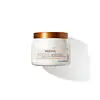What's inside
What's inside
 Key Ingredients
Key Ingredients

 Benefits
Benefits

 Concerns
Concerns

 Ingredients Side-by-side
Ingredients Side-by-side

Water
Skin ConditioningCetearyl Alcohol
EmollientAmodimethicone
Behentrimonium Chloride
PreservativeCetyl Esters
EmollientIsopropyl Alcohol
SolventParfum
MaskingTrideceth-6
EmulsifyingPhenoxyethanol
PreservativeMel
EmollientArgania Spinosa Kernel Oil
EmollientTheobroma Grandiflorum Seed Butter
Skin ConditioningCetrimonium Chloride
AntimicrobialChlorhexidine Dihydrochloride
AntimicrobialLinalool
PerfumingTocopherol
AntioxidantWater
Skin ConditioningPropylene Glycol
HumectantPolyquaternium-7
Glycol Distearate
EmollientCoco-Glucoside
CleansingGlyceryl Oleate
EmollientGlyceryl Stearate
EmollientGlycerin
HumectantPolysorbate 20
EmulsifyingCetrimonium Chloride
AntimicrobialDimethicone
EmollientQuaternium-18
Isopropyl Alcohol
SolventPhenoxyethanol
PreservativeDMDM Hydantoin
PreservativeIodopropynyl Butylcarbamate
PreservativeHydrolyzed Wheat Protein
Skin ConditioningParfum
MaskingHoney
HumectantOlea Europaea Fruit Oil
MaskingLactis Proteinum
Skin ConditioningPanthenol
Skin ConditioningTocopheryl Acetate
AntioxidantBiotin
AntiseborrhoeicAscorbic Acid
AntioxidantButyrospermum Parkii Butter
Skin ConditioningWater, Propylene Glycol, Polyquaternium-7, Glycol Distearate, Coco-Glucoside, Glyceryl Oleate, Glyceryl Stearate, Glycerin, Polysorbate 20, Cetrimonium Chloride, Dimethicone, Quaternium-18, Isopropyl Alcohol, Phenoxyethanol, DMDM Hydantoin, Iodopropynyl Butylcarbamate, Hydrolyzed Wheat Protein, Parfum, Honey, Olea Europaea Fruit Oil, Lactis Proteinum, Panthenol, Tocopheryl Acetate, Biotin, Ascorbic Acid, Butyrospermum Parkii Butter
Ingredients Explained
These ingredients are found in both products.
Ingredients higher up in an ingredient list are typically present in a larger amount.
This ingredient is a preservative, antimicrobial, and emulsifier. It is often used in cosmetics for its ability to cleanse, condition, and reduce static.
Cetrimonium chloride is a quaternary ammonium salt, meaning it has a water-soluble structure.
Isopropyl Alcohol is more commonly known as rubbing alcohol. It is most commonly used as a solvent, meaning it helps other ingredients dissolve.
This ingredient is an astringent alcohol. Astringent alcohols may also irritate skin as they high amounts may strip away your skin's natural oils.
Other types of astringent alcohols include:
According to the National Rosacea Society based in the US, you should be mindful of products with these alcohols in the top half of ingredients.
Any type of sanitizing product will have high amounts of alcohol to help kill bacteria and viruses.
Learn more about Isopropyl AlcoholParfum is a catch-all term for an ingredient or more that is used to give a scent to products.
Also called "fragrance", this ingredient can be a blend of hundreds of chemicals or plant oils. This means every product with "fragrance" or "parfum" in the ingredients list is a different mixture.
For instance, Habanolide is a proprietary trade name for a specific aroma chemical. When used as a fragrance ingredient in cosmetics, most aroma chemicals fall under the broad labeling category of “FRAGRANCE” or “PARFUM” according to EU and US regulations.
The term 'parfum' or 'fragrance' is not regulated in many countries. In many cases, it is up to the brand to define this term.
For instance, many brands choose to label themselves as "fragrance-free" because they are not using synthetic fragrances. However, their products may still contain ingredients such as essential oils that are considered a fragrance by INCI standards.
One example is Calendula flower extract. Calendula is an essential oil that still imparts a scent or 'fragrance'.
Depending on the blend, the ingredients in the mixture can cause allergies and sensitivities on the skin. Some ingredients that are known EU allergens include linalool and citronellol.
Parfum can also be used to mask or cover an unpleasant scent.
The bottom line is: not all fragrances/parfum/ingredients are created equally. If you are worried about fragrances, we recommend taking a closer look at an ingredient. And of course, we always recommend speaking with a professional.
Learn more about ParfumPhenoxyethanol is a preservative that has germicide, antimicrobial, and aromatic properties. Studies show that phenoxyethanol can prevent microbial growth. By itself, it has a scent that is similar to that of a rose.
It's often used in formulations along with Caprylyl Glycol to preserve the shelf life of products.
Water. It's the most common cosmetic ingredient of all. You'll usually see it at the top of ingredient lists, meaning that it makes up the largest part of the product.
So why is it so popular? Water most often acts as a solvent - this means that it helps dissolve other ingredients into the formulation.
You'll also recognize water as that liquid we all need to stay alive. If you see this, drink a glass of water. Stay hydrated!
Learn more about Water